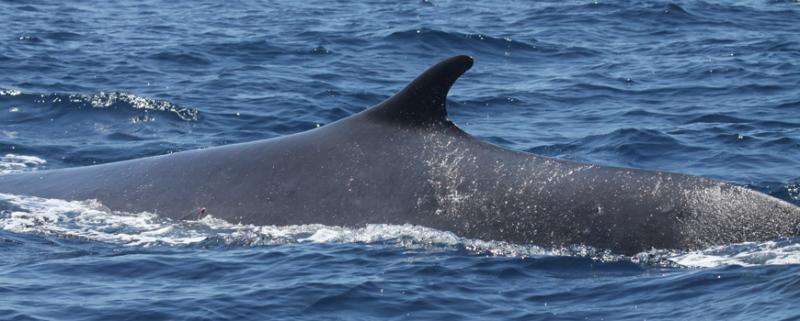Seven-year study indicates steady and upward trends for blue and fin whales in Southern California

A new study led by researchers at Scripps Institution of Oceanography at UC San Diego indicates a steady population trend for blue whales and an upward population trend for fin whales in Southern California.
Scripps marine acoustician Ana Širović and her colleagues in the Marine Bioacoustics Lab and Scripps Whale Acoustic Lab intermittently deployed 16 High-frequency Acoustic Recording Packages (HARPs)—devices that sit on the seafloor with a suspended hydrophone (an underwater microphone)—to collect acoustic data on whales off Southern California from 2006-2012.
Blue and fin whales are common inhabitants of the Southern California Bight, the curved region of California coastline with offshore waters extending from San Diego to Point Conception (near Santa Barbara, Calif.), but little is known about their use of the area.
As described in the June 24 issue of the journal Endangered Species Research, Širović and her colleagues analyzed seven years of acoustic data (26 instrument-years) to study the call abundance of blue and fin whales in the Southern California Bight. The study, largely supported by the Office of Naval Research, provides the first detailed view into the spatial use of Southern California waters by blue and fin whales, the two largest cetacean species in the world. Both are classified as endangered species.
Širović found that blue whale calls were more commonly detected at coastal sites and near the northern Channel Islands, while fin whale calls were detected further off shore, in central and southern areas.
The acoustic data indicate that the blue whale population in Southern California is relatively steady, while the fin whale population is increasing.
"I think it's an interesting difference in trends because both of the species were subject to whaling earlier in the twentieth century, and now they're clearly responding differently," said Širović, assistant researcher in the Marine Physical Laboratory at Scripps.
The acoustic data and overall trends outlined in this study are consistent with another Scripps-led study, but one that used visual data collected from 2012-2013 in the same area as part of the California Cooperative Oceanic Fisheries Investigations (CalCOFI). CalCOFI is a unique partnership led by the California Department of Fish & Wildlife, NOAA Fisheries Service, and Scripps Institution of Oceanography, and it is considered to be one of the world's most valuable marine observation programs.
Published in 2014, the Scripps research conducted through CalCOFI indicated that the blue whale population was relatively steady, while the fin whale population was increasing.
Širović cites the parallel findings between the two studies as evidence that passive acoustics can be used as a powerful tool to monitor population trends for these large marine mammals.
"I think it's very exciting that we see the same trends in the visual and acoustic data, because it indicates the possibility of using acoustics to monitor long-term trends and changes," said Širović.
Presence of a resident fin whale population in Southern California was previously suggested, and the recent study's detection of fin whale calls year-round further supports this idea.
Researchers also found that blue whale calls in the region were generally detected between June and January, evidence that supports the known seasonal migration pattern of blue whales, which tend to migrate from off the coast Mexico (or even as far down as Costa Rica) to Southern California in the late spring. The whales forage through the fall, and then leave in early winter, but researchers aren't certain where they go next.
Although researchers have studied blue and fin whales for years, Širović notes that both species are particularly mysterious, and scientists still don't know some basic information about them, such as their mating system or breeding grounds.
The Southern California Bight is a highly productive ecological territory for many marine animals due to strong upwellings, but researchers have not found any evidence that blue or fin whales are breeding there.
The productivity of the coastal region also makes it a hotbed for human activity, with large cities onshore and ships, commercial fishing vessels, and other human impacts ever-present in the water. Since fin whales generally live further offshore, Širović posits that they might have a slight advantage over blue whales, which tend to inhabit areas where there is more ship traffic—increasing their chances for ship strikes.
"It seems that for fin whales, things are probably improving," said Širović, noting that more research is needed to determine why the blue whale population is not increasing.
"For blue whales, it's a little bit harder to tell. There is a question right now as to whether their population has grown to its maximum capacity, because there are many lines of evidence showing that their population is not growing currently," said Širović. "So the question remains, is it because that's just what their population size can be maximally, or are there factors that are keeping them from growing further?"
Širović hopes that future studies can help identify why there is this difference in population trends of blue and fin whales. Now that she and her colleagues have taken a first look at the broad trends of the two species, they want to dig deeper and look into environmental drivers and other factors and features that may be causing some of the spatial distribution patterns and long-term changes of the whales.
Provided by University of California - San Diego





















